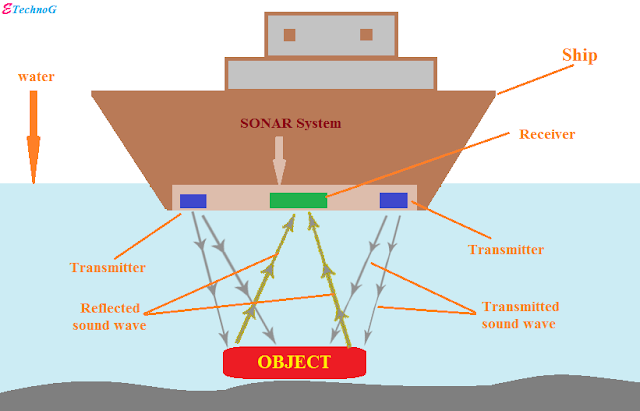Applications, Advantages, Disadvantages of SONAR Technology.
Applications, Advantages, and Disadvantages of SONAR Technology
SONAR stands for Sound Navigation And Ranging. There are huge applications of SONAR Technology. The main application of SONAR is that it uses ultrasonic waves or Sound Wave to measure the distance direction and speed of underwater objects and helps Mariners to investigate the nature size and location of the object so that potential threat to the vessel is identified and overcome. We will discuss other benefits of SONAR technology. The SONAR system is used because sound waves travel through water much better than Radio waves or Light.
There are some animals in the sea like Dolphins and bats use sound for their communication, security, and for detection of the object. They create a vibration by their body and when the sound is reflected back they can determine the objects. This concept is used in SONAR technology.
Types of SONAR Technique:
- Passive SONAR
- Active SONAR
How Passive SONAR Technique work?
Passive sonar simply listens to the sounds of the water and listens for marine life and other ships that may be nearby. Passive SONAR cannot give an idea of the actual shape of the objects.
The passive SONAR has limited application. The main application of Passive SONAR is only the detection of underwater objects.
How Active SONAR Technique work?
Active SONAR has a transmitter and a receiver which are installed at the bottom of the ship. The ultrasonic or sound waves transmitted by the transmitter and the wave travel underwater and get reflected back from underwater objects.
The detector or receiver receives the reflected signal and converts it into an electric signal. The computer decodes the electrical signals and forms an image of the underwater objects according to the electric signal and displays the actual shape of the object on a monitor.
The computer also calculates the distance of the object using the formula,
Distance = (speed*time)/2
Here,
Speed = Speed of sound in saline water = 1530 meters per second
This method of calculation of speed is called Echo Ranging.
The application of Active SONAR is more than passive SONAR.
The Transmitter in the SONAR System:
SONAR system uses the Piezoelectric Transducer. The Piezoelectric material has a property that when we apply an electric power supply to it then it creates a sound wave or vibration. So in this time, the Piezoelectric material works as sound waves or ultrasonic wave transmitters.
The Receiver or Detector in the SONAR System:
The Piezoelectric material also has a property that when sound is applied to it then it can produce an electric signal according to the sound nature. In this case, the piezoelectric material works as a sound waves or ultrasonic wave’s receiver.
Important applications of SONAR Technology:
(1) The SONAR Technique is used to determine the depth of the sea.
(2) The SONAR technique is installed in every ship to locate underwater hills, valleys, submarines, icebergs, and sunken ships, etc to avoid a disaster.
(3) The SONAR system is also used in the Military.
(4)The fishermen have used SONAR technology to find fish.
(5) The SONAR technology is also used in the medical industry like Sonography.
(6) The SONAR technology is used in the navigation system.
Advantages of SONAR Technology:
The advantages of SONAR technology are,
- The communication speed of the SONAR system is very high.
- SONAR system is not affected by the other waves like a radio wave.
- By using SONAR technology long-distance communication is possible underwater. About 80% of the Sea can be covered by the SONAR system.
- SONAR technique is not harmful to the human or animal bodies when it is used in the medical industry.
Disadvantages of SONAR Technology:
The Disadvantages of SONAR Technology are,
- Similar to the other waves its working range decreases with increasing of frequency. However, it gives high efficiency and accurate size of the objects when using high frequency.
- One single wave from the transmitter cannot give the actual size of the object. To get the accurate shape of the object we have to need to transmit the sound wave from the different directions to the object. For this reason, there are much losses occurred.
- It is affected by the other sound waves when it is used in outside the water.
- Data transfer is not possible with SONAR technology.
Difference between SONAR and RADAR Technology:
- SONAR means Sound Navigation And Ranging. RADAR stands for Radio Detection and Ranging.
- SONAR technology uses sound waves. RADAR technology uses Radio waves.
- SONAR works more efficiently underwater than outside the water. RADAR works more efficiently outside the water than underwater.
- SONAR only can be affected by other sound waves it cannot be affected by electromagnetic waves like UV, Radio waves, etc. RADAR cannot be affected by the sound wave.
Read Also:
- Applications, Uses, Advantages, Disadvantages of RADAR
- Understand Smart Grid Technology with Diagram
- Learn about Solar Power Generation System with Diagram
- Understand IoT Based Smart Agriculture System with Block Diagram
- [BEST] Applications of Optical Fiber, Advantages and Types
- Satellite Communication Block Diagram and Working Principle

